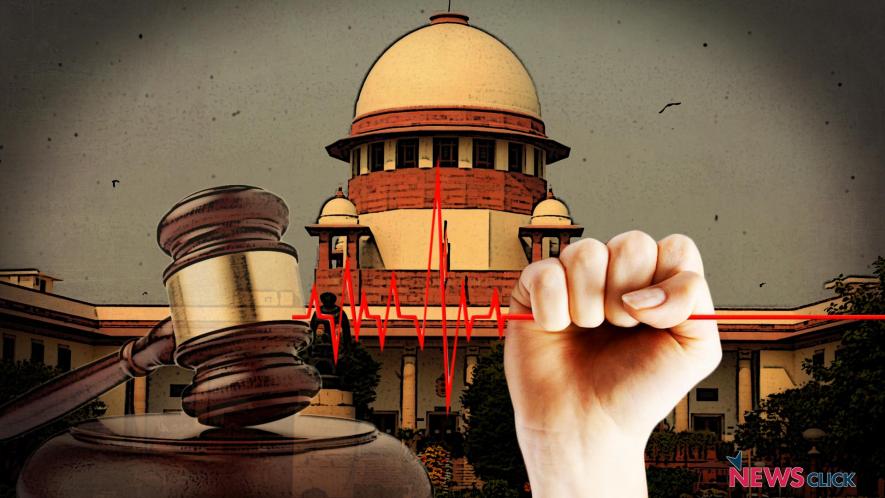The Substantive Aspects of Dying with Dignity

Newsclick Image By Sumit
The Supreme Court’s decision regarding dying with dignity as a part of Article 21 of the Constitution has received fair attention as far as the procedural aspect of the Judgement goes. The procedure has some doctors worried as the costs that will be incurred in keeping alive a person in a critical condition varies anywhere between Rs. 50,000 and 2 lakhs, not to mention the emotional toll on the family and the pain the patient would endure. However, though experts may not be overjoyed with the procedure, the substantive law is sound. The Court referred to the decisions delivered in Gian Kaur v. State of Punjab and in Aruna Ramchandra Shanbaug v. Union of India and Ors. as well as decisions delivered in other common law countries.
Gian Kaur v. State of Punjab dealt with the issue of suicide. This was a landmark decision wherein the Supreme Court overruled its previous decision in P. Rathinam v. Union of India. The previous decision recognised that the right to life included the right not to live, i.e. the right to die. However, in Gian Kaur, the Supreme Court held that the right to die could not be considered a part of the right to life as in order to die one would have to do an act. This was based on the difference between overt acts covered under fundamental rights, as well as abstentions. For example, in the case of free speech, one is equally free not to speak, i.e. not performing an act. Analysing the decision of Gian Kaur, the Supreme Court found that the question of physician-assisted suicide was never addressed. Thus, the Court concluded that there was “no definite opinion with regard to euthanasia nor has it stated that the same can be conceived of only by a legislation”. Regarding Aruna Shanbaug, which heavily relied on the Gian Kaur decision, the Supreme Court found that the reasoning was erroneous. This was because, in Aruna Shanbaug, the Court felt that Gian Kaur stated that euthanasia could be made lawful only by legislation. These two cases relied heavily on the decision in Airedale NHS Trust v. Bland, a United Kingdom decision delivered by the House of Lords. In this Judgement, the House of Lords held that active euthanasia requires a legislation whereas passive euthanasia does not.
Drawing from the legal positions in other common law jurisdictions the Supreme Court found that in the United Kingdom “whenever there is a conflict between a capable adult's exercise of the right of self-determination and the State's interest in preserving human life by treating it as sanctimonious, the right of the individual must prevail.” The position in the United States is similar as in In Re Quinlan, “where a 21-year-old girl in chronic [Permanent Vegetative State] was on ventilator support, the Court, while weighing Quinlan's right to privacy qua the State's interest in preserving human life, found that as the degree of bodily invasion increases and the prognosis for the patient's recovery dims, the patient's right to privacy increases and the State's interest weakens. The Supreme Court of New Jersey finally ruled that the unwritten constitutional right of privacy was broad enough to encompass a patient's decision to decline medical treatment in certain circumstances.” In Canada, the position is “that competent adults have the right to make their own medical decisions even if such decisions are unwise.”
The Court then looked at the 241st Law Commission Report on Passive Euthanasia, which was submitted after the Aruna Shanbaug decision. The report recommended that passive euthanasia be allowed, the Additional Solicitor General also informed the Court that there is going to be a law on passive euthanasia. The Court then analysed the concept of ‘dying with dignity’. In this regard the Court held that “as part of the right to die with dignity in case of a dying man who is terminally ill or in a persistent vegetative state, only passive euthanasia would come within the ambit of Article 21 and not the one which would fall within the description of active euthanasia in which positive steps are taken either by the treating physician or some other person. That is because the right to die with dignity is an intrinsic facet of Article 21.”
On the issue of personal autonomy and self-determination of an individual, the Court held that “all adults with the capacity to consent have a common law right to refuse medical treatment and the right of self-determination.” The Court, however, cautioned “that doctors would be bound by the choice of self-determination made by the patient who is terminally ill and undergoing a prolonged medical treatment or is surviving on life support, subject to being satisfied that the illness of the patient is incurable and there is no hope of his being cured. Any other consideration cannot pass off as being in the best interests of the patient.” This word of caution arose due to an observation made in Aruna Shanbaug that in the name of ‘best interests of the patient’, the elderly would be at risk for the sake of inheritance.
It is clear that the Court accepted the view that if withdrawing life support for a patient who is terminally ill or in a Permanent Vegetative State (PVS) or can be termed murder, then artificially keeping the patient alive in a vegetative state or in great pain can be construed as invasion of personal autonomy. Reconciling these views, the Court to arrive at its decision that withdrawing life support can be allowed where the patient is in great pain with no hope of recovery or in a PVS. Hence, the Court in a bid to add a degree of oversight to this decision has laid down directives that will function until a legislation on the matter is passed.
Get the latest reports & analysis with people's perspective on Protests, movements & deep analytical videos, discussions of the current affairs in your Telegram app. Subscribe to NewsClick's Telegram channel & get Real-Time updates on stories, as they get published on our website.
























